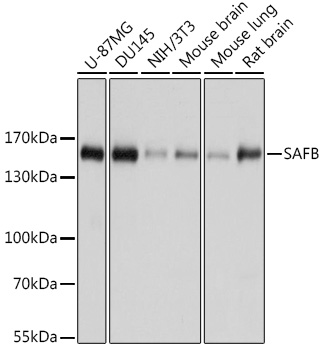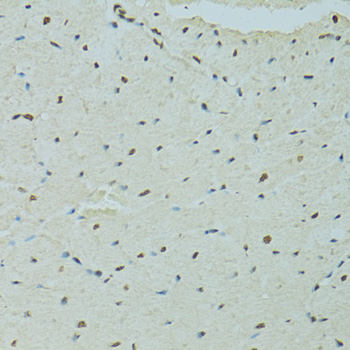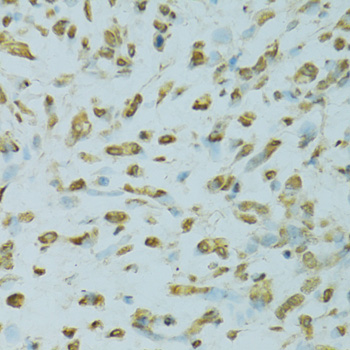Epigenetics & Nuclear Signaling Antibodies 4
Anti-SAFB Antibody (CAB7927)
- SKU:
- CAB7927
- Product Type:
- Antibody
- Reactivity:
- Human
- Reactivity:
- Mouse
- Reactivity:
- Rat
- Host Species:
- Rabbit
- Isotype:
- IgG
- Antibody Type:
- Polyclonal Antibody
- Research Area:
- Epigenetics and Nuclear Signaling
Description
| Antibody Name: | Anti-SAFB Antibody |
| Antibody SKU: | CAB7927 |
| Antibody Size: | 20uL, 50uL, 100uL |
| Application: | WB IHC IF |
| Reactivity: | Human, Mouse, Rat |
| Host Species: | Rabbit |
| Immunogen: | Recombinant fusion protein containing a sequence corresponding to amino acids 1-200 of human SAFB (NP_001188267.1). |
| Application: | WB IHC IF |
| Recommended Dilution: | WB 1:500 - 1:2000 IHC 1:50 - 1:200 IF 1:50 - 1:200 |
| Reactivity: | Human, Mouse, Rat |
| Positive Samples: | U-87MG, DU145, NIH/3T3, Mouse brain, Mouse lung, Rat brain |
| Immunogen: | Recombinant fusion protein containing a sequence corresponding to amino acids 1-200 of human SAFB (NP_001188267.1). |
| Purification Method: | Affinity purification |
| Storage Buffer: | Store at -20'C. Avoid freeze / thaw cycles. Buffer: PBS with 0.02% sodium azide, 50% glycerol, pH7.3. |
| Isotype: | IgG |
| Sequence: | MAET LSGL GDSG AAGA AALS SASS ETGT RRLS DLRV IDLR AELR KRNV DSSG NKSV LMER LKKA IEDE GGNP DEIE ITSE GNKK TSKR SSKG RKPE EEGV EDNG LEEN SGDG QEDV ETSL ENLQ DIDI MDIS VLDE AEID NGSV ADCV EDDD ADNL QESL SDSR ELVE GEMK ELPE QLQE HAIE DKET INNL DTSS SDFT |
| Gene ID: | 6294 |
| Uniprot: | Q15424 |
| Cellular Location: | Nucleus |
| Calculated MW: | 95kDa/102kDa |
| Observed MW: | 155kDa |
| Synonyms: | SAFB, HAP, HET, SAB-B1, SAF-B, SAF-B1, SAFB1 |
| Background: | This gene encodes a DNA-binding protein which has high specificity for scaffold or matrix attachment region DNA elements (S/MAR DNA). This protein is thought to be involved in attaching the base of chromatin loops to the nuclear matrix but there is conflicting evidence as to whether this protein is a component of chromatin or a nuclear matrix protein. Scaffold attachment factors are a specific subset of nuclear matrix proteins (NMP) that specifically bind to S/MAR. The encoded protein is thought to serve as a molecular base to assemble a 'transcriptosome complex' in the vicinity of actively transcribed genes. It is involved in the regulation of heat shock protein 27 transcription, can act as an estrogen receptor co-repressor and is a candidate for breast tumorigenesis. This gene is arranged head-to-head with a similar gene whose product has the same functions. Multiple transcript variants encoding different isoforms have been found for this gene. |
| UniProt Protein Function: | SAFB1: Binds to scaffold/matrix attachment region (S/MAR) DNA and forms a molecular assembly point to allow the formation of a 'transcriptosomal' complex (consisting of SR proteins and RNA polymerase II) coupling transcription and RNA processing. Can function as an estrogen receptor corepressor and can also bind to the HSP27 promoter and decrease its transcription. When associated with RBMX, binds to and stimulates transcription from the SREBF1 promoter. Can inhibit cell proliferation. |
| UniProt Protein Details: | Protein type:RNA-binding; DNA-binding; Nuclear receptor co-regulator Chromosomal Location of Human Ortholog: 19p13.3-p13.2 Cellular Component: nucleoplasm; nucleus Molecular Function:double-stranded DNA binding; protein binding Biological Process: establishment and/or maintenance of chromatin architecture |
| NCBI Summary: | This gene encodes a DNA-binding protein which has high specificity for scaffold or matrix attachment region DNA elements (S/MAR DNA). This protein is thought to be involved in attaching the base of chromatin loops to the nuclear matrix but there is conflicting evidence as to whether this protein is a component of chromatin or a nuclear matrix protein. Scaffold attachment factors are a specific subset of nuclear matrix proteins (NMP) that specifically bind to S/MAR. The encoded protein is thought to serve as a molecular base to assemble a 'transcriptosome complex' in the vicinity of actively transcribed genes. It is involved in the regulation of heat shock protein 27 transcription, can act as an estrogen receptor co-repressor and is a candidate for breast tumorigenesis. This gene is arranged head-to-head with a similar gene whose product has the same functions. Multiple transcript variants encoding different isoforms have been found for this gene.[provided by RefSeq, Jan 2011] |
| UniProt Code: | Q15424 |
| NCBI GenInfo Identifier: | 116242782 |
| NCBI Gene ID: | 6294 |
| NCBI Accession: | Q15424.4 |
| UniProt Secondary Accession: | Q15424,O60406, Q59HH8, A0AV56, B7Z5B6, B7ZLP6, F5H0H3 |
| UniProt Related Accession: | Q15424 |
| Molecular Weight: | 102,768 Da |
| NCBI Full Name: | Scaffold attachment factor B1 |
| NCBI Synonym Full Names: | scaffold attachment factor B |
| NCBI Official Symbol: | SAFB |
| NCBI Official Synonym Symbols: | HAP; HET; SAF-B; SAFB1; SAB-B1; SAF-B1 |
| NCBI Protein Information: | scaffold attachment factor B1 |
| UniProt Protein Name: | Scaffold attachment factor B1 |
| UniProt Synonym Protein Names: | HSP27 estrogen response element-TATA box-binding protein; HSP27 ERE-TATA-binding protein |
| Protein Family: | Scaffold attachment factor |
| UniProt Gene Name: | SAFB |
| UniProt Entry Name: | SAFB1_HUMAN |
View AllClose











